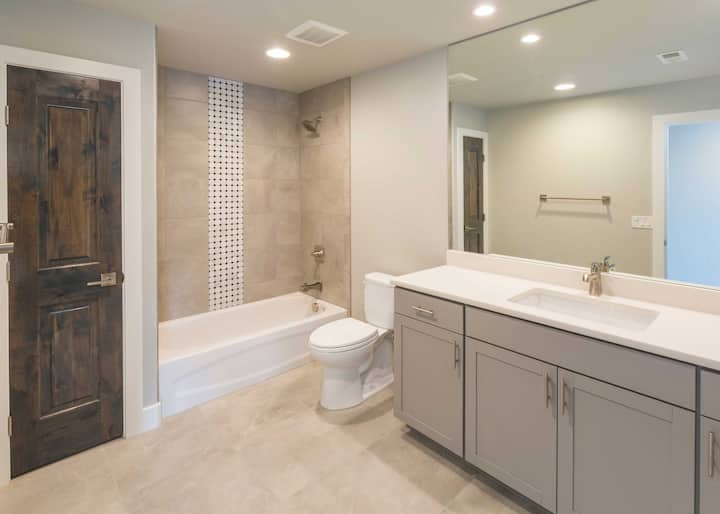
Selecting the right tile for your bathroom remodel
When it comes to bathroom remodeling, selecting the right tile can make all the difference in the final outcome. Tiles serve as both a functional and aesthetic element of a bathroom design, offering durable surfaces that withstand moisture while also adding visual interest and texture to the space.
Considering your style and color scheme
When selecting tiles for a bathroom remodel, it is essential to carefully consider the style and color scheme of the space. The tiles serve as one of the most prominent design elements in the bathroom and can either enhance or detract from the overall aesthetic. Therefore, choosing tiles that harmonize with other design features such as cabinetry, fixtures, and paint colors is crucial.
To determine a suitable style and color scheme for your bathroom remodel, start by assessing your personal taste and preferences. Are you drawn to modern or traditional designs? Do you prefer cool or warm tones? These questions can help guide your tile selection process.
Additionally, consider the size of your bathroom when making color choices. Lighter colors tend to make small spaces appear larger while darker hues create a cozy ambiance in larger bathrooms. By carefully considering these factors, you can select tiles that will not only complement but also elevate your bathroom's overall aesthetic appeal.
Evaluating the size and lighting of your bathroom
Assessing the dimensions and brightness of your restroom is crucial for creating an inviting and functional space that enhances relaxation and comfort. When selecting tiles for your bathroom remodel, it's important to keep in mind the size of your bathroom as well as its lighting conditions. Large-format tiles tend to work better in larger bathrooms, while smaller tiles can visually enlarge a small space by creating more grout lines. A good rule of thumb is to choose smaller tiles for tighter spaces or areas with lots of corners, such as showers or alcoves.
In addition to considering tile size, lighting conditions play a key role in how your bathroom will look and feel. Natural light is always best, but if this isn't possible due to the layout of your home or apartment, you should consider artificial lighting options such as overhead lights, wall-mounted sconces or under-cabinet lighting. Tiles with glossy finishes can enhance natural light by reflecting it around the room; however, if you have limited natural light sources, you may want to opt for matte-finish tiles that create a softer ambiance.
Understanding tile materials and durability
One important factor to consider in creating a durable and long-lasting bathroom is the type of tile material used. There are many materials available, including ceramic, porcelain, natural stone, glass, and vinyl. Ceramic tiles are affordable and come in a variety of colors and patterns. They are easy to clean but can crack or chip if hit with a heavy object.
Porcelain tiles are more durable than ceramic tiles as they have low water absorption rates and can withstand extreme temperatures. Natural stone tiles such as marble or granite add beauty to your bathroom but require more maintenance than other types of tiles due to their porous nature.
Glass tiles create a unique look in your bathroom as they reflect light well and come in various shapes, sizes, and colors. However, they may not be suitable for high traffic areas due to their fragility. Vinyl tiles mimic the look of natural materials at a lower cost while being water-resistant and easy to install.
Each tile material has its pros and cons based on durability, maintenance requirements, aesthetic appeal, and budget considerations. Understanding these factors will help you select the right tile material that meets your needs for your bathroom remodel project.
Factoring in maintenance and cleaning
Maintenance and cleaning are important factors to consider in ensuring the longevity and functionality of tile materials in a bathroom. While some tiles may require more maintenance than others, it is essential to choose a tile that can withstand frequent cleaning without losing its luster or color.
For instance, natural stone tiles such as marble and granite require regular sealing to prevent staining and water absorption. Porcelain tiles, on the other hand, are highly durable and do not require sealing but may need special care when removing tough stains. Regular cleaning is crucial for maintaining the hygiene of your bathroom and preventing mold growth. It is advisable to use non-abrasive cleaners that are suitable for your type of tile material. Avoid using acidic or harsh chemicals that could damage or discolor your tiles.
Exploring tile layout and design options
When it comes to tile layout and design options, careful consideration of factors such as size, shape, and color can greatly impact the overall aesthetic of a bathroom. The size of the tiles can affect how spacious or cramped a bathroom appears. Larger tiles tend to make a room look bigger while smaller ones create an illusion of more space.
Similarly, the shape of the tiles can also influence the visual perception of a bathroom. Rectangular tiles are often used to elongate walls and create a sense of height while square ones provide symmetry and balance. Color is another important factor when selecting tile for a bathroom remodel. Lighter colors reflect more light and give off an airy feel, making them ideal for small bathrooms or those with limited natural light. Darker colors add depth and drama but may require more maintenance to keep clean.
If you’re looking for bathroom tile services to complement your home, get in touch with our experienced professionals. Don’t wait – give our team a call today!